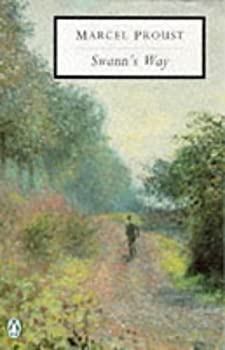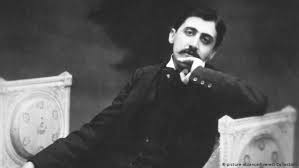Proust, Marcel: Swann’s Way


I first read Swann’s Way by Marcel Proust when I was 32, much too young and much too hurriedly. It’s not long, just 325 pages, but extended through 6 sequels to 2,271 large pages (read over the next 6 years). The print is small, the paragraphs (like concrete blocks of words) squat intimidatingly on the pages, some paragraphs taking up an entire page each, some sentences an entire paragraph, the chapters of commensurate length, only 3-5 per volume. All of which sounds daunting, and it is, but come to Proust counting time in months and weeks (not days and hours) and the labyrinthine sentences will unfurl ribbons of meaning splashing around you like ticker tape, a panoply of life filled with insights, wisdom, and “kisses with a pedal point” as Proust’s mother once signed herself off in a letter to her son.
Readability might be fine praise for a book, but growing older, having read much of what I want to read, developing a sensor for what is worth my while and what is not, I find pleasure in another kind of readability, not the kind that quickly turns pages, but the kind that resists turning the page, more fully to appreciate what is on the page just read, fearful of missing a single radiant phrase, so chockful of gems is each paragraph.
He is not without flaws, no writer is, but the greatest writers transcend their flaws; what is good about them is so very good that it trounces what is not. With Proust, a little bit goes a long way, and he has perhaps too many such little bits, too many expository longueurs—but be not deceived. Beneath the docile, bucolic, bourgeois coverlet of these pages lie dragons. The seamless tapestry may not be for everyone, but those who persevere through the pointillistic prose will find it deeper than the ocean, higher than the sky, vivid as a painting. If a picture is worth a thousand words, these are words beyond the reach of any number of pictures.
The heart of the novel couches a novella, “Swann in Love,” providing the meat of a story (beginning, middle, and end), unlike the string of vignettes sandwiching the novella, the fruit of an affair between two mismatched beings, both earning their just desserts. The series illuminates upper Parisian society during the early 20th century, going from horse-drawn carriages to motor cars, and is grounded by three love stories: Swann/Odette; boy-Marcel/Gilberte; man-Marcel/Albertine. Unfortunately, the affairs are much alike and there is much retread in the tell, but the imagery, figures of speech, and acute observations continually surprise and please. The architecture of the novel is grand, but you wonder if it might not, after all, have too many rooms. I don’t know that I would recommend the entire series, but at least the first book so the reader may make up her own mind.
I can understand the publisher who declined the novel because he couldn’t understand why a writer would open with 58 pages describing a boy turning in his bed from one side to the other (Proust self-published the first volume after other publishers declined the handwritten manuscript), and it is a wonder the book was published at all, but no less wonderful that published it was.
